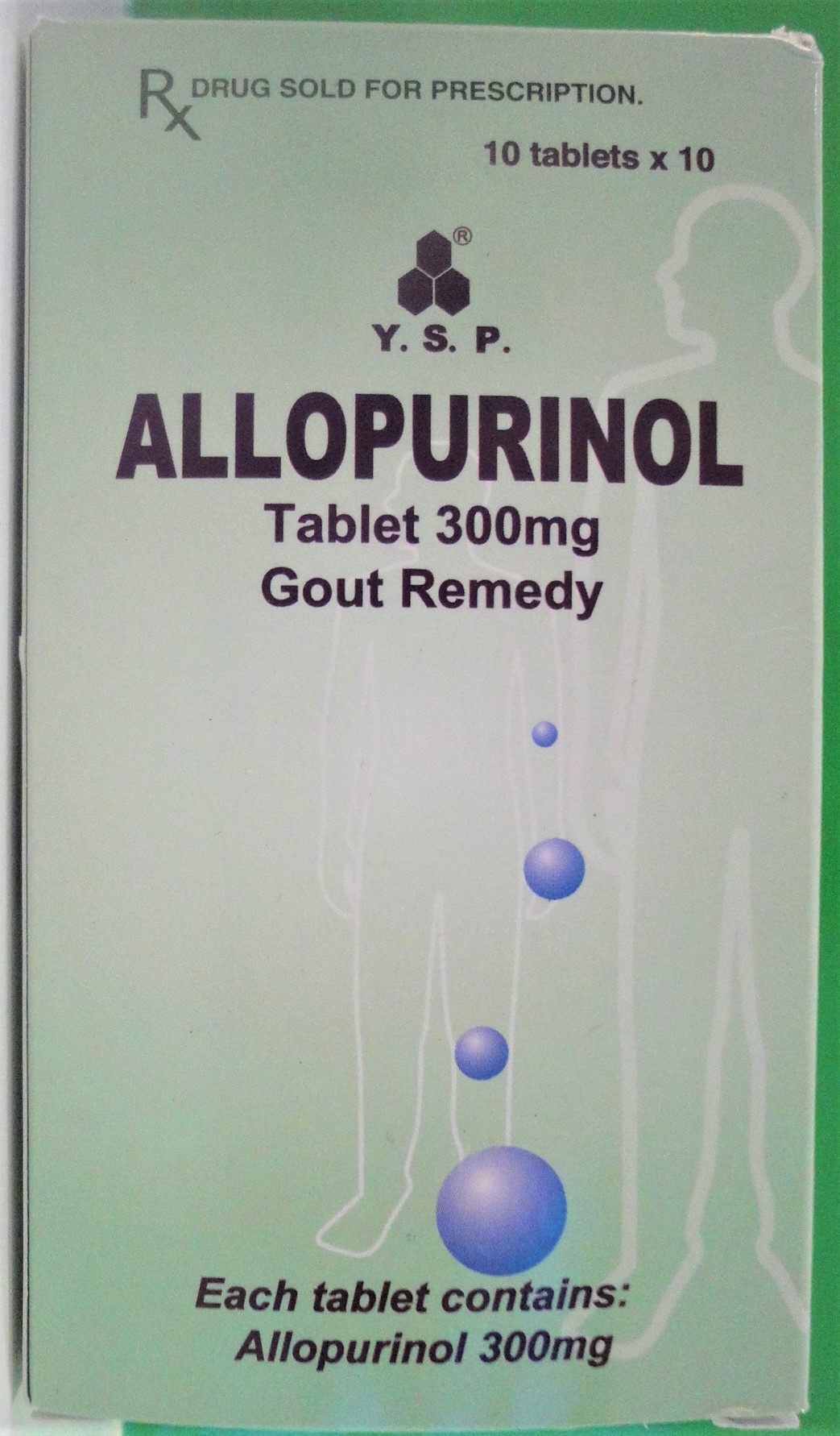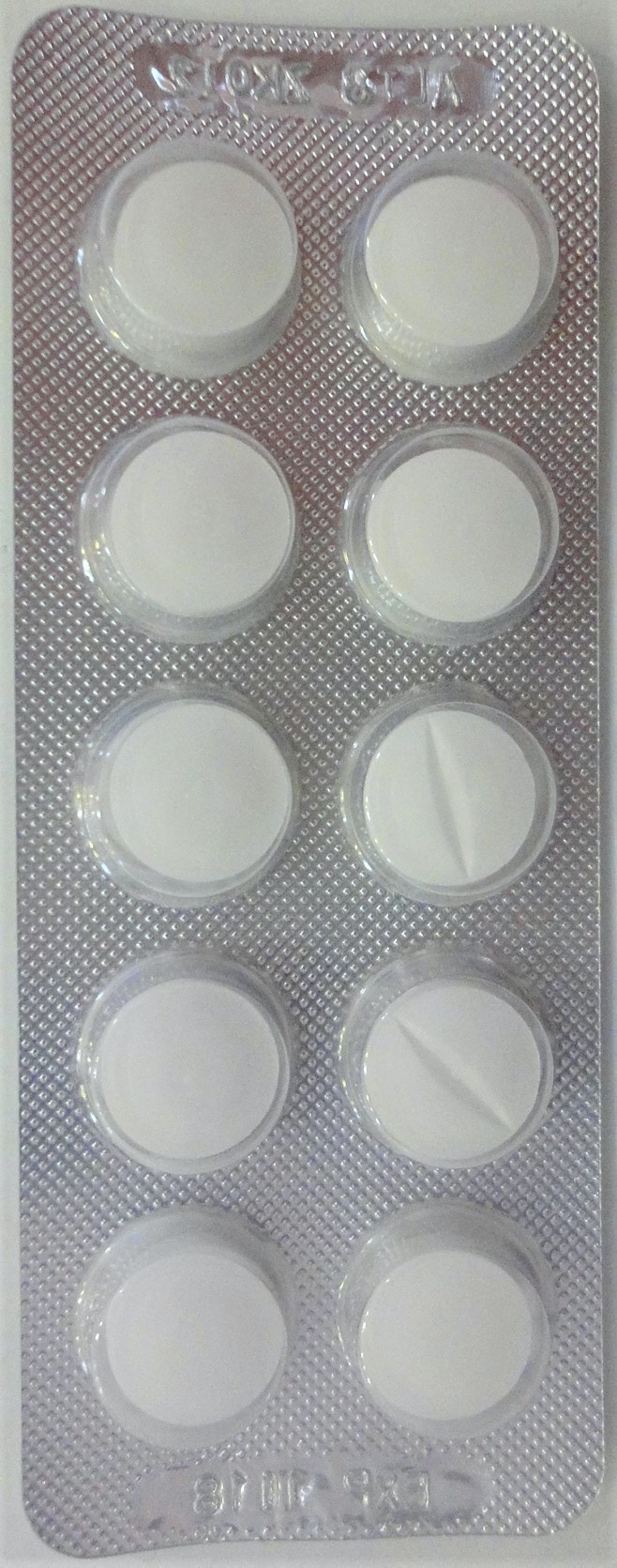ALLOPURINOL Tablet
ក្រុមហ៊ុនផលិតឱសថ:
Y.S.P. INDUSTRIES(M) SDN.BHD., Malaysia
ក្រុមហ៊ុនចែកចាយឱសថនៅប្រទេសកម្ពុជា:
INTERMEDICA


- សារធាតុសកម្ម
- ប្រសិទ្ធិភាពព្យាបាល និង កម្រិតប្រើប្រាស់
- ហាមប្រើ
- ផលរំខាន
- អន្តរប្រតិកម្ម
- ស្ត្រីមានផ្ទៃពោះ និង ស្ត្រីបំបៅដោះកូន
- ការប្រុងប្រយ័ត្នជាពិសេស
- សកម្មភាពឱសថ បរិយាយប័ណ្ណឱសថ
-
សារធាតុសកម្ម
-
ប្រសិទ្ធិភាពព្យាបាល និង កម្រិតប្រើប្រាស់
Allopurinol is indicated for the main clinical manifestations of urate/uric acide deposition. It is also indicated for management of 2,8-dihydroxyadenine(2,8-DHA) renal stone and recurrent mixed calcium oxalate renal
stones. Dosage should be adjusted by monitoring serum and
urinary urate concentrations. In general, adult: 100-200mg
daily in mild conditions, up to 900mg in severe condition. Dose requirement in excess of 300mg should be administered in divided dose.
Elderly: The lowest dosage which produces satisfactory
urate reduction should be used.
Severe renal insufficiency: < 100mg/day. Renal dialysis: Allopurinol and its metabolites are removed by renal Dialysis. If dialysis is required 2-3 times a week, consideration should be given to an alternative dosage schedule of 300-400mg allopurinol immediately after
each dialysis with none in the interim.
Children<15 years:10-20mg/kg body weigh/day or 100mg-400mg Daily.
-
ហាមប្រើ
The drug should not be employed in patients with known intolerance of allopurinol. Pending further investigation,
this drug is contraindicated for use in children with the
exception of those with hyperuricemia secondary to malignancy. Allopurinol is contraindicated as a treatment for the acute attack of gout.
-
ផលរំខាន
Skin rash , nausea, vomiting, diarrhoea and intermittent abdominal pain, maculopapular rash, alkaline phoshate
increases, SGOT/SGPT increases, fever/chills, arthralgia, cholestatic jaundice, eosinophilia, mild leucocytosis,
leukopenia, ecchymosis, headache, myopathy,
peripheral neuropathy, neuritis, paresthesia and
somnolence have been reported.
Generalised Hypersensitivity: Allopurinol should be
discontinued at the first appearance of skin rash
or other signs which may indicate an allergic reaction. Hypersensitivity to allopurinol usually appears after some weeks of thearapy, and more rarely immediately after the beginning of treatment.In rare instances, a skin rash may be followed by more severe reactions. eg. Stevens-johnson syndrome and/or generalised vasculitis, irreversible hepatotoxicity and even death.
Blood and lymphatic system: Occasional reports have been received of thrombocytopenia, agranulocytosis and aplastic anaemia particularly in individuals with impaired renal function reinforcing the need for particular care in this group of patients.
-
អន្តរប្រតិកម្ម
Allopurinol may enhance cytotoxic effects of azathioprine and mercaptopurine with increased toxicity. These interactions are potentially hazardous and combined administration of the drugs involved should be avoided.
Concurrent use of Allopurinol with captopril may result in
increased rish of toxicity, especially in renal impairment.
Allopurinol may possibly enhance effects of anticoagulants such as nicoumalone and warfarin.
Plasma-cyclosporin concentration possibly increased by Allopurinol and results in increased risk of nephrotoxicity.
The plasma half-life of adenine arabinoside is increased in the presence of allopurinol. When two products are used concomiitantly, extra vagilance is necessary to recognise enhanced toxic effects.
Oxipurinol, the major metabolites of allopurinol and itself therapeutically active, is excreted by the kidney in a similar way to urate. Hence, drugs with uricosuric activity, eg. probenecid or large doses of salicylates may accelerate the excretion of oxipurinol. This may decrease the therapeutic activity of allopurinol, but the significance needs to be assessed in each case.
If allopurinol is given concomitanly with chlorpropamide when renal fuction is poor, there may be an increased risk of prolonged hypoglycaemic activity.
Allopurinol may inhibit hepatic oxidation of phenytoin, but the clinical significance has not been demonstrated.
-
ស្ត្រីមានផ្ទៃពោះ និង ស្ត្រីបំបៅដោះកូន
There is inadequate evidence of safety of Allopurinol in human pregnancy. It should only be used in pregnancy when there is no safer alternative and when the disease itself carries risk for the mother or child. Allopurinol is excreted in human milk. There are no data concerning the effects of the drug on the beastfeed baby.
-
ការប្រុងប្រយ័ត្នជាពិសេស
a) Prophylactic administration of colchicine is advisable during the early stages of therapy to prevent precipitate of acute attacks of gout.
b) A fluid intake sufficient to yield a daily urinary output of at least 2 liters and the maintenance of a neutral or, preferably slightly alkaline urine are desirable to avoid the theoretic possibility of formation of xanthine calculi under the influence of allopurinol therapy, and to help prevent renal precipitation of urates in patients receiving concomitant uricosuric agents.
c) Patients with impaired renal function should be carefully observed during the early stages of allopurinol administration and the drug withdrawn if increased abnormalities in renal function appear.
d) It is recommended that periodic determination of liver and kidney function and complete blood counts be performed.
e) Allopurinol should be discontinued at the first appearance of skin rash or other signs which may indicate an allergic reaction. Hypersensitivity to Allopurinol usually appears after some weeks of therapy, and more rarely immediately after beginning treatment. In some instances, a skin rash may be followed by more severe reactions such as exfoliative, urticarial and purpura lesions as well as Stevens-Johnson syndrome, and/or generalized vasculitis, irreversible hepatotoxicity and even death.
f) Use in pregnancy and lactation: There is inadequate evidence of safety of Allopurinol in human pregnancy. It should only be used in pregnancy when there is no safer alternative and when the disease itself carries risk for the mother or child. Allopurinol is excreted in human milk. There are no data concerning the effects of the drug on the breastfeed baby.
-
សកម្មភាពឱសថ
a) Allopurinol acts on purine catabolism, without disrupting the biosynthesis of vital purines, by reducing the production of uric acid thus inhibiting the biochemical reaction immediately preceding its formation. Allopurinol reduces both the serum and urinary uric acid levels by inhibiting the formation or uric acid. It thereby avoids the hazard of hyperuricosuria in patients with gouty nephropathy or with a predisposition to the formation of uric acid stones.
b) Allopurinol has produced a substantial reduction in serum and urinary uric acid levels in hitherto refractory patients even in the presence of renal damage marked enough to render uricosuric drugs virtually ineffective.
c) Allopurinol is a structural analogue of the natural purine base, hypoxanthine. It is a potent inhibitor of xanthine oxidase, the enzyme responsible for the conversion of hypoxanthine to xanthine and of xanthine to uric acid, the end product of purine metabolism in man.
d) Allopurinol also inhibits the enzymatic oxidation of mercaptopurine, the sulfur-containing analogue of hypoxanthine, to 6-thiouric acid. The oxidation, which is catalyzed by xanthine oxidase, inactivates mercaptopurine.
*ព័ត៌មានឱសថត្រូវបានរៀបរៀងដោយ អ៊ីម៉ាតុគឹ មេឌីក (ខេមបូឌា) ដោយផ្អែកលើប្រភពព័ត៌មានខាងក្រោម។ សម្រាប់ព័ត៌មានលម្អិត សូមស្វែងរកនៅក្នុងក្រដាសព័ត៌មាននៃឱសថនីមួយៗ ឬ សាកសួរទៅកាន់ក្រុមហ៊ុនឱសថឬតំណាងចែកចាយនៃឱសថនីមួយៗ។
ប្រភពព័ត៌មាន៖
- ក្រដាសព័ត៌មាននៃឱសថសម្រាប់អ្នកជំនាញវេជ្ជសាស្ត្រដែលប្រើប្រាស់នៅប្រទេសជប៉ុន (Pharmaceutical and Medical Devices Agency, Pmda): https://www.pmda.go.jp
- ព័ត៌មានសង្ខេបនៃឱសថសម្រាប់អ្នកជំងឺដែលប្រើប្រាស់នៅប្រទេសជប៉ុន: http://www.rad-ar.or.jp
